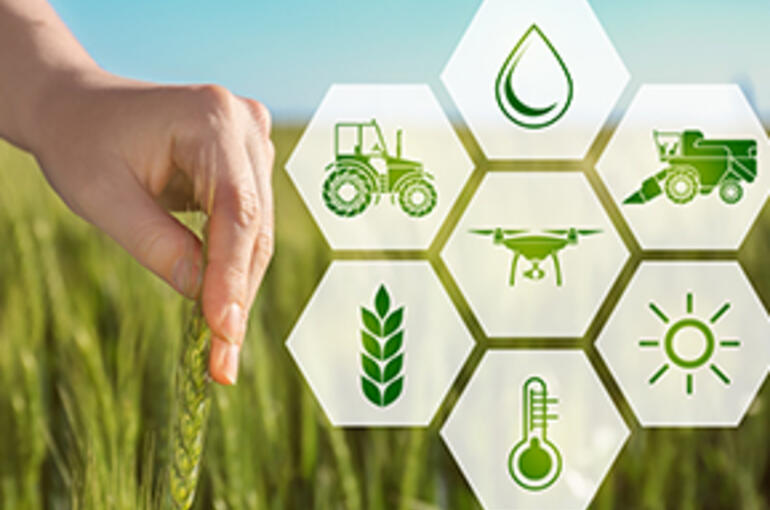- FR
- EN
New technology applied to enhance product offering and insurance services to agriculture: concrete examples

SCOR’s Annual Conference took a deep dive into the current challenge faced by (re) insurers to grow the sphere of insured risks. Read our insights on Agriculture.
SPECIFICS OF AGRICULTURE PRODUCTION
When discussing agriculture insurance, an important notion to integrate is that the science concerns living systems, capable of resolving its issues or dying. In such, each crop season is unique and depends upon multitudes of factors (external and internal to each farm).
- Historical field performance analysis: field analysis, soil type, intra-field variabilities, crop rotation, etc.
- Season planning: sub-soil moisture, season weather forecast, crop prices, etc.
- In season decision: best planting dates, agronomic prescriptions, seeding rates, etc.
- Creating an index which takes all above-mentioned into account is a difficult if not impossible endeavor.
Crop production is increasingly becoming a data driven process, with producers making use of extensive sets of technology-driven tools which attempt to increase efficiency, output and ultimately profitability. The insurance industry and their products need to equally adjust to these evolutions and take advantage of the evolving technology available.
CONCERNS TO OVERCOME
SCOR possesses a global mandate, allowing its teams to cover various territories, market specificities and farming practices. One particular feedback is common among the territories observed by the teams: producers are reluctant to purchase agriculture insurance. The reasons vary: lack of information, high expense, insufficient cover, lack of access, the belief that the government will intercede in the event of a disaster, etc. Similarly, the (re) insurance industry has expressed concerns regarding this specific business venture: heavy infrastructure costs, long investment & testing cycles, difficult insurance penetration, slow portfolio development, volatility of results and income, portfolio diversification, asymmetry of information, moral hazard, anti-selection, etc. It has become necessary to change this paradigm in order for insurance to become a fully integrated tool in production risk management. For this to occur, the insurers’ and producers’ interests must be aligned, with insurance products rewarding best farming practices. The common goal must be the stabilization and optimization of producer returns.
CASE STUDY: MONGOLIA
The Mongolian government and SCOR have a long-lasting relationship through livestock insurance. Several years ago, the government decided to develop their agriculture production, specifically wheat as the good is too expensive to import and the nation is not self-sufficient - agriculture insurance is part of this strategy due to extreme weather conditions. Mongolia is composed of comparatively large farms and fields, in vastly remote areas and their coverage at the time consisted of a traditional MPCI (Multi-Peril Crop Insurance) cover, which had been in place for two years. The approach undertaken in Mongolia to model wheat yields was composed of several elements:
- Calibration of plant models for wheat, specific to Mongolian circumstances;
- Yields generated artificially on the basis of weather data over the past ten years (5x5 km pixels);
- Aggregation of yield outputs on logical geographical units;
- The purchase of an insurance policy based on location;
- Trigger of a pay-out based on actual weather conditions and the calibrated model (according to seed variety and the planting date).
Several challenges presented themselves:
- Different grid lengths of data;
- Detrending of yields;
- Geographical aggregation;
- Calibration of model: as insurance incorporates outliers, is the model able to match all pay-out cases?
KEY TAKE-AWAYS
Agriculture concerns are living systems, seasonal dynamics and resilience:
- Data quantity and availability do not mirror biological reality - only new methods and interlinks between data can approach agriculture realities on the ground.
- An important part of product roll-out is driven by testing, as well as discussing the results with clients, which makes it a long-term undertaking.
New technologies are tools, not methods:
- The development of a new tool does not change reality.
- An in-depth understanding of the socio-economic farming environment is key.
- Insurance needs to be in line with new farming trends and adjust their product design and offer accordingly.
- Data collection, storage and computing power are no longer a challenge - the application will be the differentiator.
- Data cleansing and validation is complex - outliers must remain the focus.
New technology should not replace traditional methods, but enhance them:
- The roles of agriculture insurance will evolve from a pure loss compensation role to become an advisory partner for producers.
- “Boots on the ground” will remain a relevant part of agriculture insurance.
About the authors
Michael Rüegger is Deputy Chief Underwriting Officer of the Agriculture specialty team at SCOR and was at the origin of the building of the current Agriculture underwriting team, responsible for many emerging countries such as China, Korea, Turkey, Russia and some further European Countries, and Latin America including Brazil. He holds a master’s degree in environmental sciences from the Federal Institute of Technology in Switzerland. Before joining the reinsurance industry, he worked in Alpine natural disaster prevention and spent several seasons as a herdsman. In 1998, he joined the Winterthur Insurance Group in the department for Strategy and Organization, before entering, the reinsurance department of Winterthur Insurance as a junior agriculture underwriter in 1999. During the merger of Winterthur Re with Partner Re in 2000, he took over the coordination of the Latin American operations of the new Agriculture department at PartnerRe, located in Buenos Aires, Argentina. In 2003, he joined GE Insurance Solutions to re-structure GE IS Latin American Operations in agriculture and then joined SCOR in 2006.
Fanny Rosset is a Senior underwriter at SCOR Global P&C with 12 years’ experience in agriculture reinsurance, including 5 years as a pricing actuary. Fanny graduated with MSc. in Actuarial Sciences in 2006. After graduation, Fanny joined SCOR as a pricing actuary for property and agriculture businesses, then specialized in agriculture business.